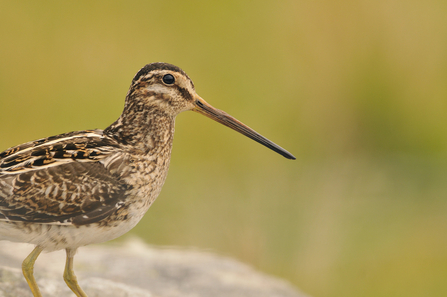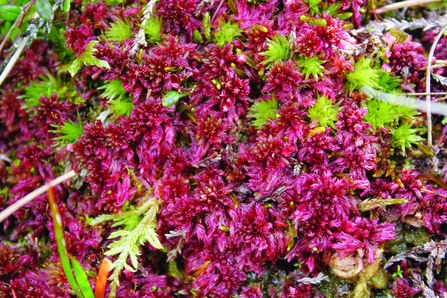Our peatland restoration work, including on Shap Fells above, was recently awarded a £250,000 grant from the Green Recovery Challenge Fund © Cumbria Wildlife Trust
Government inertia on peatlands risks international embarrassment
Damaged peatlands release CO2 into the atmosphere, so it’s hugely important to address this for the climate crisis.CEO, Cumbria Wildlife Trust
This year, as the UK hosts the global climate conference, COP26, all eyes will be on the UK’s own action to tackle climate change. The Wildlife Trusts believe that the Government’s failure to address a key issue – how to end the damage to carbon-storing peatlands and restore a significant proportion of those that are already harmed – will be a major embarrassment.
Peatlands are the UK’s largest on-land store of carbon, holding three times as much as woodlands. They store around 3.2 billion tonnes of carbon, but in their current degraded condition they release the equivalent of 23 million tonnes of CO2 every year. That's 5% of the UK’s annual greenhouse gas emissions. They are a precious wildlife habitat and vital for holding back and filtering water. Their benefits to society are immense. But a high proportion of UK peatlands have been damaged, drained, extracted and burnt over decades of misuse.
Indications that the Government will fail on this issue are:
- There is still no sign of the long-promised England peat strategy – it was due in December 2018. The Wildlife Trusts believe that it will lack the ambition needed to address climate chaos and the decline of nature.
- The Government has said it will restore 35,000 hectares of England’s peatlands by 2025. Yet their own advisors recently estimated that around 300,000 hectares should be repaired in England. This initial commitment will see England delivering just 1/40th of the amount recommended for the UK. The Climate Change Committee has said that about 1,400,000 hectares of peatlands need restoring across the UK by 2050.
- The Government has pledged only £50 million towards peatland restoration in England. This is unambitious when set beside the £2 billion figure that will likely be needed to restore the area of peatlands that the Climate Change Committee says is needed across the UK.
- The Government’s recent announcement of a partial ban on peat burning was underwhelming; burning will only cease across a small number of peatlands despite a recent commitment by Lord Goldsmith to halt the practice entirely on protected sites.

Peatland restoration benefits the wildlife that peatlands support such as snipe © Fergus Gill/2020VISION
Steve Trotter, CEO of Cumbria Wildlife Trust says:
“In the UK at least 80% of peatlands are damaged. Unfortunately, the condition of peatland soils in Cumbria is in a similarly poor condition. Our survey found that over 95% of peatlands surveyed were in poor management condition, so it’s crucial that we do what we can to repair them, for the sake of wildlife and the environment.”
Stephen explains why damaged peatlands need to be repaired: “Damaged peatlands release CO2 into the atmosphere, so it’s hugely important to address this for the climate crisis. We estimate that in their current condition, the Cumbrian peatlands are releasing the equivalent of 222,769 tonnes of CO2 into the atmosphere every year. To put this figure into perspective, the carbon cost of visitors, coming to and from the Lake District annually, is estimated to be 941,356 tonnes CO2.
“Here in Cumbria, the Cumbria Peat Partnership has worked to put some 4000ha of peatland into restoration. We’re very grateful for the funding we’ve received from Defra, the Environment Agency, Natural England, the National Lottery Heritage Fund, the Esmée Fairbairn Foundation, Landfill Tax operators, EU Life programme and the members of Cumbria Wildlife Trust – which has made this work possible in recent years. Most recently, the Trust has been awarded a £250,000 grant from the Green Recovery Challenge Fund for peatland work on Shap Fells and Armboth Fell. An estimated £30-40million is still required to complete the task of restoring Cumbria’s bogs which form part of the Great North Bog of Northern England so we’re pleased with progress so far but we need to sustain and increase the amount we invest in peat.’
“As well as helping to reduce CO2 emissions, repaired peatlands will also improve the water quality on the sites and reduce the risk of flooding downstream. The work will also benefit wildlife that peatlands support: plants like sundews, butterwort and bladderworts have evolved on peatlands to be carnivorous, getting nutrition from small insects and flies. Curlew, golden plover and snipe breed in summer on Cumbria’s peat bogs, and short-eared owls and hen harriers hunt across these areas too.”
Peatland restoration can be done by blocking up drainage ditches, rewetting and replanting with sphagnum mosses that help form new layers of peat and trap moisture.

Replanting with sphagnum mosses helps to form new layers of peat and trap moisture © Cumbria Wildlife Trust
